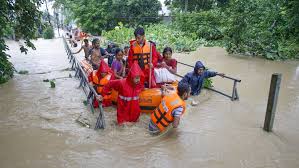ISLAMABAD: A week-long heat wave in Gilgit Baltistan had increased meltingrate of glaciers resulting in flooding which caused destruction to the NaltarExpressway and subsequently damaged electricity power plant in Nomal.
A flash flood from Baltoro glacier in Beraldu river eroded agricultural land and the road toTestun village. Major roads in GB like Shahra e Baltistan, Karakoram highway (KKH)faced blockages and damages due to erosion caused by rising water level forcingthe locals to displace.
Glacier formation takes decade by accumulation of snowfall at higher altitude or Polar Regionswhere a cold temperature facilitates the process. The layers of snow are burdened by their ownweight that makes a denser form of ice, eventually over the time with extra pressure glacier is form.
The melting ice is a source of water which travels through channels towards valleys. The mostcommon way of the formation of glacial lack is glacial damming where a flow of river is blockedwhen glacier move down a valley.
Global warming has caused an increase in melting rate and slowed down the accumulation of snow.Particularly in summers, melting rate is higher by 0.5 % as compared to other seasons. Melting iceoften breaks a heavy mass of ice leading to blockade of river flow, eventually a glacial lake is formed.
Heavy rainfall or an earthquake can rupture the dam leading to a devastating release of water whichis known as Glacial Lake Outburst Flooding (GLOF).GB has more than 2000 glaciers among which 33 are at great risk of GLOF, and is home to globallyknown glaciers like Siachen, Bultoro, and Hisper. These glaciers are source of water for irrigation andagriculture in Pakistan.
These glacial lakes merge into the Indus River which passes through theregion, flowing into rivers of Punjab and Sindh before reaching the Arabian Sea. This increases therisk of flooding in the Indus especially in the summer months.
Presently glaciers are melting faster than ever due to a global warming. According to a reportpublished in Nature Communications, four countries are at higher risk to GLOF, where approximately15 million people are vulnerable to damage. Pakistan is included among these vulnerable countrieswith estimated population of 13 million at risk, from which 7.3 million people are from GB andKhyber Pakhtunkhwa (KP).
National Disaster Management Authority (NDMA) in a recent press release on July 17, 2024, warnedGB and KP regions regarding a potential threat of GLOFs during monsoons in 2024. NDMA hadinstructed Provincial Disaster Management Authorities (PDMAs) to ensure safety and takeprecautionary steps to placate any danger.
According to NDMA an increase in temperature, heavy rainfall, and overflow of glacial lakes can be the main cause of floods and it could cause an increasein water level of rivers, landslides and flash floods. This can lead to widespread damage likesweeping away infrastructure, damaging crops, and casualties. In response departments had beentold to alert local communities and travellers to minimize unnecessary travel. NDMA has alsolaunched an online application to provide timely alerts and give instructions to manage risks.
A glacial outburst on May 7, 2022, from Shispar glacier caused collapse of Hassan Abad Bridge inHunza, which is permanent trade route between China and Pakistan. This resulted in blockade ofKKH and impacted the ecosystem of the area. It destroyed 52 Houses, hundreds of trees, hydropower plants, cultivated land and led to displacement of people. The flood halted the trade betweenthe countries causing economic losses to the region and the country.
Furthermore, in July 2018 due to melting of glacier and heavy rainfall GLOF caused flooding in Ghizarvalley and debris from it blocked Kurumbar River. The flooding destroyed roads, bridges, crops, 30houses and forced people to evacuate their house.
The UNDP in its newsletter in June 2021, highlighted concerns about fund management provided byit for different projects to deal with GLOFs (GLOF I and GLOF II). On June 17, 2021, an AutomatedWeather Station (AWS) was set up on Shisper Glacier with funding from the Green Climate Fund.
Byoffering real-time data on climate-induced incidents, this AWS, which is a component of the UNDP’sGLOF II project, seeks to enhance the disaster management capabilities of the PakistanMeteorological Department. But due to governance issues these projects have not been operatingefficiently and this issue needs attention of the Government as highlighted by UNDP.
Glaciers are melting at faster rate due to an increase in temperature and climate change.Communities are vulnerable to threats by flooding. Past GLOF events have caused significantdamage to ecosystem, agriculture, economy and local community.
Tourism generates income formany households, any damage to infrastructure leads to economic loss and least visitors. Economicdiversification is very essential to unlock income opportunities. Tourism is seasonal profession andis easily affected by climate change. Effective management strategies like community preparedness,early warning system and resilient infrastructure is needed to mitigate risks.


